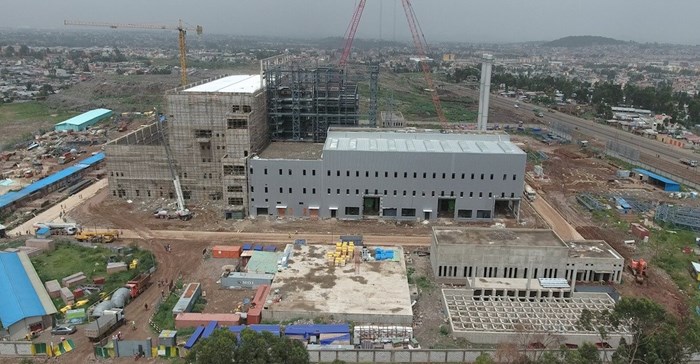Sub-Saharan Africa produces approximately 62-million tonnes of waste per year, including plastic waste, according to the World Bank. With Africa's rapid urbanisation and economic growth, environmentalists expect that figure to double by 2025.

Reppie thermal plant. Photo: Cambridge Industries
Yet Africa’s epidemic of waste may very well contain the seeds of a solution to another stubborn problem—the energy shortage.
Some 609-million people (six out of 10) have no access to electricity in the sub-Saharan region, and about 80% of those in rural areas lack electricity access, according to 2017 data by the World Bank. Manufacturers experience an average of 56 days of shutdown time per year due to power outages, the African Development Bank noted in 2017.
To achieve universal energy access, Africa requires an investment of more than $1.5trn in the energy sector between 2018 and 2050. Without such an investment, sub-Saharan Africa will be home to an estimated 89% of the world’s energy poor by 2030, according to a 2017 report by the International Energy Agency (IEA), an organisation that advises governments on energy policy.
Waste for Africa
To meet demand, exploration is underway to convert the mounting piles of rubbish into much-needed energy—and some countries are already showing how that can be done.
This year Ethiopia completed the Reppie thermal plant, Africa’s first waste-to-energy plant, which has the capacity to incinerate 1,400 tons of waste per day. The plant handles 80% of Addis Ababa’s waste and converts it into electricity that, when the plant becomes fully operational, will serve three million people—thus providing 30% of the capital city’s needs.
To execute the $120m project, the Ethiopian government partnered with China National Electric Engineering Co., which worked with Cambridge Industries and its managing director Samuel Alemayehu, a Stanford-educated engineer and former Silicon Valley entrepreneur.
“The Reppie project is just one component of Ethiopia’s broader strategy to address pollution and embrace renewable energy across all sectors of the economy,” Zerubabel Getachew, Ethiopia’s deputy permanent representative to the United Nations, told UN Environment. “We hope that Reppie will serve as a model for other countries in the region and around the world.”
With only 4% of the continent’s wastes being recycled, Africa’s waste management is still in its infancy, according to a 2018 report by UN Environment and South Africa's Council for Scientific and Industrial Research.
South Africa may be an outlier. PET Recycling Company, a South African recycling company, reported in 2016 that plastic bottle recycled tonnage has grown by 822% in the country since 2005.
“Currently South Africa does not have mandatory punitive legislation in place which makes separation of recyclables [from the waste stream]… in homes, offices, restaurants and bars compulsory. Mandatory separation at the source will ensure greater recycling success in years to come,” said Shabeer Jhetam, executive director at the Glass Recycling Company.
Morocco tops in solar energy
The sun could be another source of sustainable energy in Africa. Africa has 117% more sunshine than Germany, the global leader in solar energy.
Due to its decreasing cost and increasing convenience, solar energy is projected to become the world’s largest source of energy by 2050, states a 2017 report by the International Renewable Energy Agency, an intergovernmental organisation promoting sustainable energy.
Lighting Africa, a World Bank–supported project started by music icon Akon, his childhood friend Thione Niang and Malian philanthropist Samba Bathily, is tapping into Africa’s vast solar resource. The group hopes to provide solar energy solutions to 250-million people across sub-Saharan Africa by 2030.
Since its establishment in 2014, Lighting Africa has provided electricity access to nearly 29-million people in 25 African countries, including Benin, Guinea, Mali, Niger and Sierra Leone.
Morocco leads the pack in solar energy in Africa. With 32% of its energy needs currently coming from renewable sources, the country is on track to hit 44% by 2020.
Morocco’s solar energy ambition is anchored on the $9bn Ouarzazate Solar Power Station (OSPS), also called Noor Power Station (noor means "light" in Arabic), located in the Drâa-Tafilalet region. The OSPS is expected to produce electricity for over one million homes by the end of 2018. The Spanish consortium TSK-Acciona-Sener is helping to develop the project.
Oil reigns supreme
However, some countries’ reliance on fossil fuels for energy and revenue may be hampering investments in renewables. Nigeria, for example, produces and sells about 2.2 million barrels of oil per day, which accounted for 69% of its revenues in 2017, reported Nigeria’s Central Bank.
Without the capacity to refine sufficient oil for domestic consumption, Nigeria subsidises fossil fuel production by up to $2.5bn yearly, notes the IEA, which warns that such subsidies put undue strain on governments’ budgets and create obstacles for emerging low-carbon businesses and the renewables sector.
Angola, Côte d’Ivoire, Mozambique, Tanzania, Zambia, and Zimbabwe, among other countries, each subsidised fossil fuel production by more than $1bn in 2015, states the International Centre for Trade and Sustainable Development (ICTSG), a Geneva-based organization that promotes sustainable development through trade-related policies.
Even South Africa increased its subsidy for fossil fuels from $2.9bn in 2014 to $3.5bn in 2016, despite a commitment the country made at the 2009 G20 summit to phase out subsidies, notes the the Organisation for Economic Co-operation and Development, whose members are the world’s richest nations. South Africa is also home to 31-billion tonnes of recoverable coal, the sixth largest in the world.
Both the Paris Agreement and Goal 12 of the 2030 Agenda for Sustainable Development require countries to focus less on fossil fuels and more on renewables. African governments are concerned that phasing out subsidies could trigger hikes in the cost of petroleum products and electricity, leading to social unrest.
“Subsidies to fossil fuel power are provided [by African countries] to compensate for electricity tariffs, which cover only 70% of the cost of power production,” states ICTSG.
Fingers crossed, Morocco’s success in solar energy development, Ethiopia’s Reppie thermal plant and renewables successes elsewhere may encourage other African countries to pay attention to sustainable practices.
























